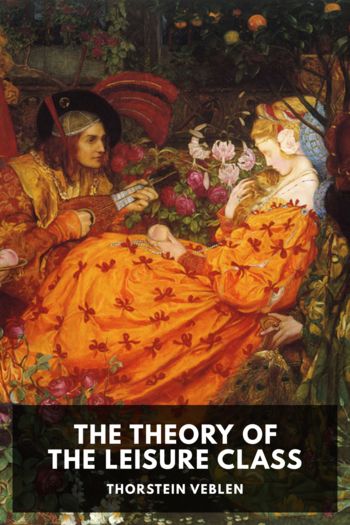The Theory of the Leisure Class by Thorstein Veblen (phonics readers TXT) 📕

- Author: Thorstein Veblen
Book online «The Theory of the Leisure Class by Thorstein Veblen (phonics readers TXT) 📕». Author Thorstein Veblen
The dress of women goes even farther than that of men in the way of demonstrating the wearer’s abstinence from productive employment. It needs no argument to enforce the generalization that the more elegant styles of feminine bonnets go even farther towards making work impossible than does the man’s high hat. The woman’s shoe adds the so-called French heel to the evidence of enforced leisure afforded by its polish; because this high heel obviously makes any, even the simplest and most necessary manual work extremely difficult. The like is true even in a higher degree of the skirt and the rest of the drapery which characterizes woman’s dress. The substantial reason for our tenacious attachment to the skirt is just this; it is expensive and it hampers the wearer at every turn and incapacitates her for all useful exertion. The like is true of the feminine custom of wearing the hair excessively long.
But the woman’s apparel not only goes beyond that of the modern man in the degree in which it argues exemption from labor; it also adds a peculiar and highly characteristic feature which differs in kind from anything habitually practiced by the men. This feature is the class of contrivances of which the corset is the typical example. The corset is, in economic theory, substantially a mutilation, undergone for the purpose of lowering the subject’s vitality and rendering her permanently and obviously unfit for work. It is true, the corset impairs the personal attractions of the wearer, but the loss suffered on that score is offset by the gain in reputability which comes of her visibly increased expensiveness and infirmity. It may broadly be set down that the womanliness of woman’s apparel resolves itself, in point of substantial fact, into the more effective hindrance to useful exertion offered by the garments peculiar to women. This difference between masculine and feminine apparel is here simply pointed out as a characteristic feature. The ground of its occurrence will be discussed presently.
So far, then, we have, as the great and dominant norm of dress, the broad principle of conspicuous waste. Subsidiary to this principle, and as a corollary under it, we get as a second norm the principle of conspicuous leisure. In dress construction this norm works out in the shape of diverse contrivances going to show that the wearer does not and, as far as it may conveniently be shown, can not engage in productive labor. Beyond these two principles there is a third of scarcely less constraining force, which will occur to anyone who reflects at all on the subject. Dress must not only be conspicuously expensive and inconvenient, it must at the same time be up to date. No explanation at all satisfactory has hitherto been offered of the phenomenon of changing fashions. The imperative requirement of dressing in the latest accredited manner, as well as the fact that this accredited fashion constantly changes from season to season, is sufficiently familiar to everyone, but the theory of this flux and change has not been worked out. We may of course say, with perfect consistency and truthfulness, that this principle of novelty is another corollary under the law of conspicuous waste. Obviously, if each garment is permitted to serve for but a brief term, and if none of last season’s apparel is carried over and made further use of during the present season, the wasteful expenditure on dress is greatly increased. This is good as far as it goes, but it is negative only. Pretty much all that this consideration warrants us in saying is that the norm of conspicuous waste exercises a controlling surveillance in all matters of dress, so that any change in the fashions must conspicuous waste exercises a controlling surveillance in all matters of dress, so that any change in the fashions must conform to the requirement of wastefulness; it leaves unanswered the





Comments (0)